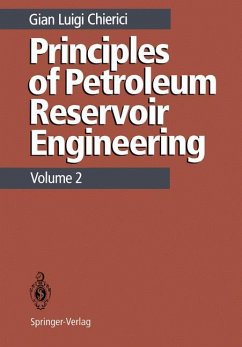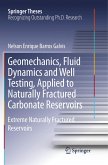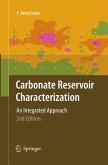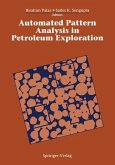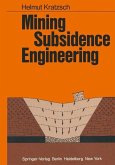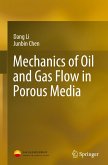- Broschiertes Buch
- Merkliste
- Auf die Merkliste
- Bewerten Bewerten
- Teilen
- Produkt teilen
- Produkterinnerung
- Produkterinnerung
Volume 1 of this book dealt with the techniques behind the acquisition, processing and interpretation of basic reservoir data. This second vol ume is devoted to the study, verification and prediction of reservoir behaviour, and methods of increasing productivity and oil recovery. I should like to bring a few points to the reader's attention. Firstly, the treatment of immiscible displacement by the method of characteristics. The advantage of this approach is that it brings into evidence the various physical aspects of the process, especially its dependence on the properties of the fluids…mehr
Andere Kunden interessierten sich auch für
![Geomechanics, Fluid Dynamics and Well Testing, Applied to Naturally Fractured Carbonate Reservoirs Geomechanics, Fluid Dynamics and Well Testing, Applied to Naturally Fractured Carbonate Reservoirs]() Nelson Enrique Barros GalvisGeomechanics, Fluid Dynamics and Well Testing, Applied to Naturally Fractured Carbonate Reservoirs82,99 €
Nelson Enrique Barros GalvisGeomechanics, Fluid Dynamics and Well Testing, Applied to Naturally Fractured Carbonate Reservoirs82,99 €![Geomechanics, Fluid Dynamics and Well Testing, Applied to Naturally Fractured Carbonate Reservoirs Geomechanics, Fluid Dynamics and Well Testing, Applied to Naturally Fractured Carbonate Reservoirs]() Nelson Enrique Barros GalvisGeomechanics, Fluid Dynamics and Well Testing, Applied to Naturally Fractured Carbonate Reservoirs90,99 €
Nelson Enrique Barros GalvisGeomechanics, Fluid Dynamics and Well Testing, Applied to Naturally Fractured Carbonate Reservoirs90,99 €![Carbonate Reservoir Characterization Carbonate Reservoir Characterization]() F. Jerry LuciaCarbonate Reservoir Characterization164,99 €
F. Jerry LuciaCarbonate Reservoir Characterization164,99 €![Automated Pattern Analysis in Petroleum Exploration Automated Pattern Analysis in Petroleum Exploration]() PalazAutomated Pattern Analysis in Petroleum Exploration121,99 €
PalazAutomated Pattern Analysis in Petroleum Exploration121,99 €![Mining Subsidence Engineering Mining Subsidence Engineering]() H. KratzschMining Subsidence Engineering81,99 €
H. KratzschMining Subsidence Engineering81,99 €![Monitoring Induced Seismicity Monitoring Induced Seismicity]() Monitoring Induced Seismicity81,99 €
Monitoring Induced Seismicity81,99 €![Mechanics of Oil and Gas Flow in Porous Media Mechanics of Oil and Gas Flow in Porous Media]() Dang LiMechanics of Oil and Gas Flow in Porous Media75,99 €
Dang LiMechanics of Oil and Gas Flow in Porous Media75,99 €-
-
-
Volume 1 of this book dealt with the techniques behind the acquisition, processing and interpretation of basic reservoir data. This second vol ume is devoted to the study, verification and prediction of reservoir behaviour, and methods of increasing productivity and oil recovery. I should like to bring a few points to the reader's attention. Firstly, the treatment of immiscible displacement by the method of characteristics. The advantage of this approach is that it brings into evidence the various physical aspects of the process, especially its dependence on the properties of the fluids concerned, and on the velocity of displacement. It was not until after the publication of the first, Italian, edition of this book (February 1990) that I discovered a similar treatment in the book Enhanced Oil Recovery, by Larry W. Lake, published in 1989. Another topic that I should like to bring to the reader's attention is the forecasting of reservoir behaviour by the method of identified models. This original contribution to reservoir engineering is based on systems theory - a science which should, in my opinion, find far wider applica tion, in view of the "black box" nature of reservoirs and their responses to production processes.
Produktdetails
- Produktdetails
- Verlag: Springer / Springer Berlin Heidelberg / Springer, Berlin
- Artikelnr. des Verlages: 978-3-642-78245-9
- Softcover reprint of the original 1st ed. 1995
- Seitenzahl: 428
- Erscheinungstermin: 30. Dezember 2011
- Englisch
- Abmessung: 270mm x 193mm x 24mm
- Gewicht: 921g
- ISBN-13: 9783642782459
- ISBN-10: 3642782450
- Artikelnr.: 36120679
- Herstellerkennzeichnung Die Herstellerinformationen sind derzeit nicht verfügbar.
- Verlag: Springer / Springer Berlin Heidelberg / Springer, Berlin
- Artikelnr. des Verlages: 978-3-642-78245-9
- Softcover reprint of the original 1st ed. 1995
- Seitenzahl: 428
- Erscheinungstermin: 30. Dezember 2011
- Englisch
- Abmessung: 270mm x 193mm x 24mm
- Gewicht: 921g
- ISBN-13: 9783642782459
- ISBN-10: 3642782450
- Artikelnr.: 36120679
- Herstellerkennzeichnung Die Herstellerinformationen sind derzeit nicht verfügbar.
The book deals with the basic physical principles regarding the optimized development and exploitation of oil and gas reservoirs. It can be used in university courses and by professional petroleum engineers as a source of reference.
11 Immiscible Displacement in Homogeneous Porous Media.- 11.1 Introduction.- 11.2 Basic Assumptions.- 11.3 Displacement in One-Dimensional Systems.- 11.3.1 The Fractional Flow Equation.- 11.3.2 The Buckley-Leverett Displacement Equation.- 11.3.2.1 Case 1 - Fractional Flow Curve fW(SW) Concave Downwards.- 11.3.2.2 Case 2 - Fractional Flow Curve fW(SW) Concave Upwards.- 11.3.2.3 Case 3 - Fractional Flow Curve fW(SW) S-Shaped.- 11.3.3 Calculation of the Average Saturation Behind the Front: Welge's Equation.- 11.3.4 Calculation of Oil Recovery as a Function of Time, and the Fraction of Displacing Fluid in the Production Stream.- 11.3.5 The Effect of Oil Viscosity and Flow Rate on Displacement.- 11.3.6 Frontal Instability: Fingering.- 11.4 Displacement in a Two-Dimensional System (x, z).- 11.4.1 Segregated Flow - the Concept of Vertical Equilibrium (VE).- 11.4.2 Gravity Stabilisation of the Front in Segregated Flow.- 11.5 Relative Permeability and Capillary Pressure Pseudo-Curves.- 11.5.1 Total Layer Thickness ht Much Less Than the Height hc of the Capillary Transition Zone.- 11.5.2 Total Layer Thickness ht of the Same Order as the Height hc of the Capillary Transition Zone.- 11.5.3 Total Layer Thickness ht, Much Greater Than the Height hc of the Capillary Transition Zone.- References.- Exercises.- 11.1 Calculation of Sw,f and ER,o at water breakthrough for three different water/oil viscosity ratios, p. 41. - 11.2 Calculation of Sw,f, (fw)Bt and ED for the vertical displacement of oil by water, at three different frontal velocities, p. 44. - 11.3 Calculation of the critical velocity for the displacement of oil by gas, for five different sets of rock and fluid properties, p. 47. - 11.4 Calculation of the oil recovery factor for vertical displacement by gas,for five different velocities of the gas front, p. 48..- 12 The Injection of Water into the Reservoir.- 12.1 Introduction.- 12.2 The Development of Water Injection Technology.- 12.3 Factors Influencing Oil Recovery by Water Injection.- 12.4 ED: Microscopic Displacement Efficiency.- 12.5 Ev: Volumetric Efficiency.- 12.5.1 EA: Areal Sweep Efficiency.- 12.5.2 EI: Vertical Invasion Efficiency.- 12.5.2.1 Layers Not in Vertical Communication.- 12.5.2.2 Layers with Vertical Communication.- 12.6 Deformation of the Water/Oil Contact in the Near-Wellbore Region: "Water Coning".- 12.6.1 Calculation of the Critical Flow Rate for Water Coning.- 12.6.2 Production Above the Critical Rate.- 12.7 Surveys and Tests in Reservoirs Produced Under Water Injection.- 12.7.1 Monitoring the Advance of the Water Front.- 12.7.2 Interwell Testing.- References.- Exercises.- 12.1 Calculation of fw as a function of ER,o, and ER,o(t) for the injection of water in a direct line drive pattern, p. 98. - 12.2 Calculation of the areal sweep efficiency EA(fw) for water injection in direct and staggered line drive patterns, at different values of Mwo. p. 101. - 12.3 Calculation of the pseudo-relative permeability curves for a multilayered reservoir, with vertical interlayer communication, p. 104. - 12.4 Program to calculate the pseudo-curves of relative permeability and capillary pressure in segregated and dispersed flow regimes for reservoirs consisting of several layers in vertical communication, p. 107. - 12.5 Calculation of the vertical invasion efficiency curve EI(fw) as a function of the fraction of water produced, for a reservoir consisting of several layers not in vertical communication, p. 114. - 12.6 Calculation of the critical oil flow rate for water coning for different penetrationratio and reservoir anisotropy, p. 118. - 12.7 Calculation of the time to water breakthrough, and the subsequent behaviour of fw in a well producing oil above the critical rate for water coning, p. 119..- 13 The Simulation of Reservoir Behaviour Using Numerical Modelling.- 13.1 Introduction.- 13.2 The Philosophy and Methodology Behind Numerical Modelling.- 13.3 Types of Numerical Model.- 13.3.1 Classification Based on the Way in Which the Flow Equations Are Discretised.- 13.3.2 Classification Based on Reservoir Geometry.- 13.3.3 Classification Based on the Number and Nature of the Mobile Phases.- 13.4 The Continuity Equation.- 13.5 The Flow Equation.- 13.6 Single Phase Flow of a Slightly Compressible Fluid.- 13.7 Single Phase Flow of Gas.- 13.8 Multiphase Flow.- 13.9 Generalised Compositional Equation for Multiphase Flow.- 13.10 Discussion of the Flow Equations.- 13.10.1 Monophasic Flow.- 13.10.2 Biphasic Flow.- 13.10.3 Triphasic Flow.- 13.11 Basic Principles of the Finite Difference Method.- 13.11.1 Discretisation.- 13.11.2 Types of Grid (or Mesh).- 13.11.3 Discretisation of Derivatives into Finite Differences.- 13.11.4 Choice of Time for the Spatial Derivative, and the Conditions for Stability.- 13.11.5 Rounding and Truncation Errors.- 13.12 Numerical Simulation of Single Phase Flow.- 13.12.1 The Finite Difference Equation for Single Phase Flow.- 13.12.2 Matrix Form of the Finite Difference Equation for Single Phase Flow.- 13.13 Solution of the Linear Algebraic Equations Derived from the Discretisation of the Flow Equation.- 13.13.1 Introduction.- 13.13.2 Direct Methods.- 13.13.2.1 The Gaussian Elimination Method.- 13.13.2.2 Triangular Matrices.- 13.13.2.3 Factorisation of the Coefficient Matrix.- 13.13.2.4 The Ordering of Sparse Matrices.- 13.13.3 IterativeProcedures.- 13.13.3.1 Introduction.- 13.13.3.2 The Point Jacobi Method (Simultaneous Displacement).- 13.13.3.3 The Point Gauss-Seidel Method (Successive Displacement).- 13.13.3.4 Point Successive Over-Relaxation (SOR).- 13.13.3.5 A Simple Example of the Use of Iterative Methods.- 13.13.4 Methods for Alternating Directions.- 13.13.4.1 Introduction.- 13.13.4.2 The ADI Method.- 13.13.4.3 The IADI Method.- 13.14 Numerical Simulation of Multiphase Flow.- 13.14.1 The Finite Difference Equation for Multiphase Flow.- 13.14.2 Numerical Dispersion and Its Treatment in Multiphase Flow.- 13.14.3 Solution of the Finite Difference Equation for Multiphase Flow.- 13.14.3.1 Choice of Solution Method.- 13.14.3.2 The IMPES Method.- 13.14.3.3 The Method of Simultaneous Solution.- 13.14.3.4 The Fully Implicit Method.- 13.15 Introduction to the Study of Reservoir Behaviour Through Numerical Modelling.- 13.16 Gathering, Editing and Preprocessing the Basic Data.- 13.16.1 Choice of Gridding for Reservoir Discretisation.- 13.16.2 Gross and Net Pay Thickness for Each Layer.- 13.16.3 Porosity and Pore Compressibility.- 13.16.4 Horizontal Permeability.- 13.16.5 Vertical Permeability.- 13.16.6 The Correlation Parameter.- 13.16.7 Capillary Pressure Curves.- 13.16.8 Relative Permeability Curves.- 13.16.9 PVT Properties.- 13.16.10 Initial Gas/Oil and Water/Oil Contacts.- 13.16.11 Initial Pressure and Temperature at the Reference Datum, and the Temperature Gradient.- 13.17 Initialisation of the Model.- 13.17.1 Calculation of Geometrical Parameters.- 13.17.2 Calculation of Phase Pressures.- 13.17.3 Calculation of Capillary Pressures and Saturations.- 13.17.4 Calculation of the Initial Volume of Fluids in the Reservoir.- 13.17.5 Plotting the Iso-Value Maps.- 13.18 Choice of Model and Method of Simulation.- 13.18.1 Choice of Model.- 13.18.2 Convergence and Stability Criteria.- 13.18.3 Simulation of the Displacement Process: Choice of Relative Permeability and Capillary Pressure Pseudo-Curves.- 13.19 Validation of the Numerical Model by Matching the Reservoir History.- 13.19.1 Scope and Methodology of the Validation Process.- 13.19.2 Data Needed for History Matching.- 13.19.3 Use of the Model in History Matching.- 13.19.4 Checking the History Match.- 13.20 Forecasting Reservoir Behaviour.- 13.20.1 Introduction.- 13.20.2 Production Constraints.- 13.20.2.1 Well Constraints.- 13.20.2.2 Surface Facility Constraints.- 13.20.2.3 Reservoir Constraints.- 13.20.3 Calculation of Well Flow Rates.- 13.20.3.1 Introduction.- 13.20.3.2 Wells Producing at Fixed Rates.- 13.20.3.3 Wells Producing at Deliverability.- 13.21 Summary.- References.- Exercises.- 13.1 Derivation of the continuity equation in radial coordinates, p. 213. - 13.2 Derivation of an expression for the coefficient a in Eq. (13.16b) for one- and two-dimensional geometries, p. 214. - 13.3 Derivation of equations to describe the behaviour of a reservoir containing a moderately volatile oil, and a black oil, from the generalised compositional equation (Eq. (13.41)] for polyphasic flow. p. 217. - 13.4 Derivation of Eq. (13.77), for the z-axis component of the transport term. p. 220. - 13.5 Derivation of the finite difference equations for three-dimensional polyphasic flow. p. 222. - 13.6 Expression of the general transport term in fully implicit form, eliminating non-linearity, p. 226..- 14 Forecasting Well and Reservoir Performance Through the Use of Decline Curves and Identified Models.- 14.1 Introduction.- 14.2 Production Decline Curves.- 14.2.1 Conditions for the Use of Decline Curves.- 14.2.2 TheCharacteristics of Decline Curves.- 14.2.3 Practical Applications of the Decline Curve Method.- 14.3 Identified Models.- 14.3.1 The Reservoir and Aquifer as a Single Dynamic System.- 14.3.2 The Basics of Systems Theory.- 14.3.2.1 Definitions.- 14.3.2.2 The "z-Transform".- 14.3.3 Discrete Dynamic Systems.- 14.3.4 The Model Identification Procedure.- 14.3.4.1 Ordering of the Model.- 14.3.4.2 Determination of the Parameters of the Model.- 14.3.4.3 Evaluation of Model Stability.- 14.3.5 Practical Example: Identification of a Gas Reservoir with an Aquifer.- 14.3.5.1 Initial Considerations.- 14.3.5.2 The Minerbio Gas Reservoir.- 14.3.5.3 Determination of the Order of the Model.- 14.3.5.4 Investigation of the Conditions for Time Invariance.- 14.3.5.5 Validation of the Identified Model.- References.- Exercises.- 14.1 Use of decline curves to determine the incremental cumulative production at abandonment of a reservoir where infill wells have been drilled, p. 251..- 15 Techniques for Improving the Oil Recovery.- 15.1 Introduction.- 15.2 The Current Status of the World's Oil Reserves.- 15.3 Quantity and Distribution of Oil Remaining in the Reservoir.- 15.3.1 Introduction.- 15.3.2 Methods for Evaluating the Overall Quantity of Remaining Oil.- 15.3.2.1 The Material Balance Method.- 15.3.2.2 Single Well Tracer Test.- 15.3.3 Determination of the Distribution of Remaining Oil Throughout the Reservoir.- 15.3.3.1 Retrieval and Analysis of Downhole Cores.- 15.3.3.2 Resistivity Logs.- 15.3.3.3 Pulsed Neutron Logs (PNL).- 15.3.3.4 Nuclear Magnetism Log (NML).- 15.4 ARM - Advanced Reservoir Management: Improvement of the Oil Recovery Factor by Optimisation of Water or Gas Injection.- 15.4.1 ARM for Water Injection.- 15.4.1.1 The Effect of Well-Spacing on Oil Recovery by WaterInjection.- 15.4.1.2 Why Infill Drilling Can Lead to an Increase in Oil Recovery.- 15.4.1.3 Optimising Infill Well Location by ARM Techniques.- 15.4.2 Crestal Injection of Non-Miscible Gas.- 15.4.2.1 Unidirectional Displacement of Oil by Gas in the Presence of Siw.- 15.4.2.2 Vertical Displacement of Oil by Gas in a Gravity-Stabilised Regime.- 15.4.2.3 Production of Oil Through Vertical Displacement by Gas Under Gravity-Dominated Conditions.- 15.5 Enhanced Oil Recovery (EOR): Definition and Classification of Methods.- 15.5.1 Introduction.- 15.5.2 Types of Enhanced Oil Recovery Methods.- 15.6 Steam Drive.- 15.6.1 The Influence of Temperature on Reservoir Rock and Fluid Properties.- 15.6.2 Steam Drive Technology.- 15.6.3 Problems Encountered in the Reservoir.- 15.6.4 Summary.- 15.7 Huff'n'puff, or Steam Soak.- 15.7.1 Origins of the Method.- 15.7.2 Steam Soak Technology.- 15.7.3 Reservoir Engineering Considerations.- 15.8 In Situ Combustion.- 15.8.1 Principles of the Method.- 15.8.2 What Happens in the Reservoir.- 15.8.3 Wet Combustion.- 15.8.4 Injection of Oxygen or Oxygen-Enriched Air.- 15.8.5 Summary.- 15.9 Miscible Gas Flooding.- 15.9.1 Introduction.- 15.9.2 Pseudo-Ternary Diagrams for the Reservoir Oil/Injection Gas Mixture.- 15.9.3 Phase Behaviour of a Mixture of Reservoir Oil/Gaseous Hydrocarbon and/or Nitrogen.- 15.9.3.1 Use of Pseudo-Ternary Diagrams to Describe Phase Behaviour..- 15.9.3.2 First Contact Miscibility.- 15.9.3.3 Multiple Contact Miscibility: Condensing Gas Drive.- 15.9.3.4 Multiple Contact Miscibility: Vaporising Gas Drive.- 15.9.4 Phase Behaviour of a Mixture of Reservoir Oil and Carbon Dioxide.- 15.9.4.1 Thermodynamic Properties of Carbon Dioxide.- 15.9.4.2 Type I Behaviour of a Mixture of Reservoir Oil and Carbon Dioxide.- 15.9.4.3 Type IIBehaviour of a Mixture of Reservoir Oil and Carbon Dioxide.- 15.9.5 Correlations for the Estimation of Minimum Miscibility Pressure (MMP).- 15.9.5.1 Vaporising Gas Drive.- 15.9.5.2 Condensing and Vaporising Gas Drives.- 15.9.5.3 Miscibility of Oil and Nitrogen.- 15.9.5.4 Miscible Displacement with Carbon Dioxide.- 15.9.6 Flow Regimes Encountered in Miscible Gas Drive.- 15.9.7 Displacement Under Gravity-Stabilised Conditions.- 15.9.8 Miscible Gas Drive Technology.- 15.9.9 Immiscible Flooding and Huff'n puff Using Carbon Dioxide.- 15.9.10 Summary.- 15.10 Polymer Flooding.- 15.10.1 Introduction.- 15.10.2 Polymers Used.- 15.10.3 Rheology of Polymer Solutions.- 15.10.3.1 Overview of Rheology.- 15.10.3.2 Polymer Solutions.- 15.10.4 Improvement of the Permeability Profile with Polymer Gels.- 15.10.5 Polymer Technology.- 15.10.6 Summary.- 15.11 Micellar/Polymer Flooding.- 15.11.1 Introduction.- 15.11.2 Water/Oil/Surfactant Micellar Solutions.- 15.11.3 Phase Behaviour of Water/Oil/Surfactant + Cosurfactant Systems.- 15.11.3.1 Type II(?) Systems.- 15.11.3.2 Type II(+) Systems.- 15.11.3.3 Type III Systems.- 15.11.4 The Effect of Water Salinity on the Properties of the System.- 15.11.5 Adsorption by the Reservoir Rock (Surfactant Retention).- 15.11.6 Micellar-Polymer Flooding Technology.- 15.11.7 Summary.- 15.12 Caustic Flooding.- 15.12.1 Introduction.- 15.12.2 The Interactions Behind the Process.- 15.12.3 Caustic Flooding Technology.- 15.12.4 Summary.- 15.13 Monitoring EOR Performance in the Reservoir.- 15.13.1 Classical Methods.- 15.13.2 Seismic Methods.- 15.13.2.1 Spatial Distribution of Fluid Saturations by 3D Seismic Surveys.- 15.13.2.2 Interwell Distribution of Fluid Saturations by Cross-Well Seismics.- 15.13.3 Electrical and Electromagnetic Methods.- 15.13.3.1 DCElectrical Techniques.- 15.13.3.2 Electromagnetic (EM) Methods.- 15.13.3.2.1 Controlled Source Audio Magnetic Tellurics (CSAMT).- 15.13.3.2.2 High-Frequency Electromagnetic (HFEM) Method.- 15.13.4 Summary.- 15.14 Selection of the Appropriate EOR Process for a Given Field.- 15.15 The Future of EOR.- References.- Exercises.- 15.1 Derivation of the equations relating oil recovery at breakthrough and Ngv, and the Corey n-exponent, for vertical non-miscible gas displacement, p. 369..- Author Index.
11 Immiscible Displacement in Homogeneous Porous Media.- 11.1 Introduction.- 11.2 Basic Assumptions.- 11.3 Displacement in One-Dimensional Systems.- 11.3.1 The Fractional Flow Equation.- 11.3.2 The Buckley-Leverett Displacement Equation.- 11.3.2.1 Case 1 - Fractional Flow Curve fW(SW) Concave Downwards.- 11.3.2.2 Case 2 - Fractional Flow Curve fW(SW) Concave Upwards.- 11.3.2.3 Case 3 - Fractional Flow Curve fW(SW) S-Shaped.- 11.3.3 Calculation of the Average Saturation Behind the Front: Welge's Equation.- 11.3.4 Calculation of Oil Recovery as a Function of Time, and the Fraction of Displacing Fluid in the Production Stream.- 11.3.5 The Effect of Oil Viscosity and Flow Rate on Displacement.- 11.3.6 Frontal Instability: Fingering.- 11.4 Displacement in a Two-Dimensional System (x, z).- 11.4.1 Segregated Flow - the Concept of Vertical Equilibrium (VE).- 11.4.2 Gravity Stabilisation of the Front in Segregated Flow.- 11.5 Relative Permeability and Capillary Pressure Pseudo-Curves.- 11.5.1 Total Layer Thickness ht Much Less Than the Height hc of the Capillary Transition Zone.- 11.5.2 Total Layer Thickness ht of the Same Order as the Height hc of the Capillary Transition Zone.- 11.5.3 Total Layer Thickness ht, Much Greater Than the Height hc of the Capillary Transition Zone.- References.- Exercises.- 11.1 Calculation of Sw,f and ER,o at water breakthrough for three different water/oil viscosity ratios, p. 41. - 11.2 Calculation of Sw,f, (fw)Bt and ED for the vertical displacement of oil by water, at three different frontal velocities, p. 44. - 11.3 Calculation of the critical velocity for the displacement of oil by gas, for five different sets of rock and fluid properties, p. 47. - 11.4 Calculation of the oil recovery factor for vertical displacement by gas,for five different velocities of the gas front, p. 48..- 12 The Injection of Water into the Reservoir.- 12.1 Introduction.- 12.2 The Development of Water Injection Technology.- 12.3 Factors Influencing Oil Recovery by Water Injection.- 12.4 ED: Microscopic Displacement Efficiency.- 12.5 Ev: Volumetric Efficiency.- 12.5.1 EA: Areal Sweep Efficiency.- 12.5.2 EI: Vertical Invasion Efficiency.- 12.5.2.1 Layers Not in Vertical Communication.- 12.5.2.2 Layers with Vertical Communication.- 12.6 Deformation of the Water/Oil Contact in the Near-Wellbore Region: "Water Coning".- 12.6.1 Calculation of the Critical Flow Rate for Water Coning.- 12.6.2 Production Above the Critical Rate.- 12.7 Surveys and Tests in Reservoirs Produced Under Water Injection.- 12.7.1 Monitoring the Advance of the Water Front.- 12.7.2 Interwell Testing.- References.- Exercises.- 12.1 Calculation of fw as a function of ER,o, and ER,o(t) for the injection of water in a direct line drive pattern, p. 98. - 12.2 Calculation of the areal sweep efficiency EA(fw) for water injection in direct and staggered line drive patterns, at different values of Mwo. p. 101. - 12.3 Calculation of the pseudo-relative permeability curves for a multilayered reservoir, with vertical interlayer communication, p. 104. - 12.4 Program to calculate the pseudo-curves of relative permeability and capillary pressure in segregated and dispersed flow regimes for reservoirs consisting of several layers in vertical communication, p. 107. - 12.5 Calculation of the vertical invasion efficiency curve EI(fw) as a function of the fraction of water produced, for a reservoir consisting of several layers not in vertical communication, p. 114. - 12.6 Calculation of the critical oil flow rate for water coning for different penetrationratio and reservoir anisotropy, p. 118. - 12.7 Calculation of the time to water breakthrough, and the subsequent behaviour of fw in a well producing oil above the critical rate for water coning, p. 119..- 13 The Simulation of Reservoir Behaviour Using Numerical Modelling.- 13.1 Introduction.- 13.2 The Philosophy and Methodology Behind Numerical Modelling.- 13.3 Types of Numerical Model.- 13.3.1 Classification Based on the Way in Which the Flow Equations Are Discretised.- 13.3.2 Classification Based on Reservoir Geometry.- 13.3.3 Classification Based on the Number and Nature of the Mobile Phases.- 13.4 The Continuity Equation.- 13.5 The Flow Equation.- 13.6 Single Phase Flow of a Slightly Compressible Fluid.- 13.7 Single Phase Flow of Gas.- 13.8 Multiphase Flow.- 13.9 Generalised Compositional Equation for Multiphase Flow.- 13.10 Discussion of the Flow Equations.- 13.10.1 Monophasic Flow.- 13.10.2 Biphasic Flow.- 13.10.3 Triphasic Flow.- 13.11 Basic Principles of the Finite Difference Method.- 13.11.1 Discretisation.- 13.11.2 Types of Grid (or Mesh).- 13.11.3 Discretisation of Derivatives into Finite Differences.- 13.11.4 Choice of Time for the Spatial Derivative, and the Conditions for Stability.- 13.11.5 Rounding and Truncation Errors.- 13.12 Numerical Simulation of Single Phase Flow.- 13.12.1 The Finite Difference Equation for Single Phase Flow.- 13.12.2 Matrix Form of the Finite Difference Equation for Single Phase Flow.- 13.13 Solution of the Linear Algebraic Equations Derived from the Discretisation of the Flow Equation.- 13.13.1 Introduction.- 13.13.2 Direct Methods.- 13.13.2.1 The Gaussian Elimination Method.- 13.13.2.2 Triangular Matrices.- 13.13.2.3 Factorisation of the Coefficient Matrix.- 13.13.2.4 The Ordering of Sparse Matrices.- 13.13.3 IterativeProcedures.- 13.13.3.1 Introduction.- 13.13.3.2 The Point Jacobi Method (Simultaneous Displacement).- 13.13.3.3 The Point Gauss-Seidel Method (Successive Displacement).- 13.13.3.4 Point Successive Over-Relaxation (SOR).- 13.13.3.5 A Simple Example of the Use of Iterative Methods.- 13.13.4 Methods for Alternating Directions.- 13.13.4.1 Introduction.- 13.13.4.2 The ADI Method.- 13.13.4.3 The IADI Method.- 13.14 Numerical Simulation of Multiphase Flow.- 13.14.1 The Finite Difference Equation for Multiphase Flow.- 13.14.2 Numerical Dispersion and Its Treatment in Multiphase Flow.- 13.14.3 Solution of the Finite Difference Equation for Multiphase Flow.- 13.14.3.1 Choice of Solution Method.- 13.14.3.2 The IMPES Method.- 13.14.3.3 The Method of Simultaneous Solution.- 13.14.3.4 The Fully Implicit Method.- 13.15 Introduction to the Study of Reservoir Behaviour Through Numerical Modelling.- 13.16 Gathering, Editing and Preprocessing the Basic Data.- 13.16.1 Choice of Gridding for Reservoir Discretisation.- 13.16.2 Gross and Net Pay Thickness for Each Layer.- 13.16.3 Porosity and Pore Compressibility.- 13.16.4 Horizontal Permeability.- 13.16.5 Vertical Permeability.- 13.16.6 The Correlation Parameter.- 13.16.7 Capillary Pressure Curves.- 13.16.8 Relative Permeability Curves.- 13.16.9 PVT Properties.- 13.16.10 Initial Gas/Oil and Water/Oil Contacts.- 13.16.11 Initial Pressure and Temperature at the Reference Datum, and the Temperature Gradient.- 13.17 Initialisation of the Model.- 13.17.1 Calculation of Geometrical Parameters.- 13.17.2 Calculation of Phase Pressures.- 13.17.3 Calculation of Capillary Pressures and Saturations.- 13.17.4 Calculation of the Initial Volume of Fluids in the Reservoir.- 13.17.5 Plotting the Iso-Value Maps.- 13.18 Choice of Model and Method of Simulation.- 13.18.1 Choice of Model.- 13.18.2 Convergence and Stability Criteria.- 13.18.3 Simulation of the Displacement Process: Choice of Relative Permeability and Capillary Pressure Pseudo-Curves.- 13.19 Validation of the Numerical Model by Matching the Reservoir History.- 13.19.1 Scope and Methodology of the Validation Process.- 13.19.2 Data Needed for History Matching.- 13.19.3 Use of the Model in History Matching.- 13.19.4 Checking the History Match.- 13.20 Forecasting Reservoir Behaviour.- 13.20.1 Introduction.- 13.20.2 Production Constraints.- 13.20.2.1 Well Constraints.- 13.20.2.2 Surface Facility Constraints.- 13.20.2.3 Reservoir Constraints.- 13.20.3 Calculation of Well Flow Rates.- 13.20.3.1 Introduction.- 13.20.3.2 Wells Producing at Fixed Rates.- 13.20.3.3 Wells Producing at Deliverability.- 13.21 Summary.- References.- Exercises.- 13.1 Derivation of the continuity equation in radial coordinates, p. 213. - 13.2 Derivation of an expression for the coefficient a in Eq. (13.16b) for one- and two-dimensional geometries, p. 214. - 13.3 Derivation of equations to describe the behaviour of a reservoir containing a moderately volatile oil, and a black oil, from the generalised compositional equation (Eq. (13.41)] for polyphasic flow. p. 217. - 13.4 Derivation of Eq. (13.77), for the z-axis component of the transport term. p. 220. - 13.5 Derivation of the finite difference equations for three-dimensional polyphasic flow. p. 222. - 13.6 Expression of the general transport term in fully implicit form, eliminating non-linearity, p. 226..- 14 Forecasting Well and Reservoir Performance Through the Use of Decline Curves and Identified Models.- 14.1 Introduction.- 14.2 Production Decline Curves.- 14.2.1 Conditions for the Use of Decline Curves.- 14.2.2 TheCharacteristics of Decline Curves.- 14.2.3 Practical Applications of the Decline Curve Method.- 14.3 Identified Models.- 14.3.1 The Reservoir and Aquifer as a Single Dynamic System.- 14.3.2 The Basics of Systems Theory.- 14.3.2.1 Definitions.- 14.3.2.2 The "z-Transform".- 14.3.3 Discrete Dynamic Systems.- 14.3.4 The Model Identification Procedure.- 14.3.4.1 Ordering of the Model.- 14.3.4.2 Determination of the Parameters of the Model.- 14.3.4.3 Evaluation of Model Stability.- 14.3.5 Practical Example: Identification of a Gas Reservoir with an Aquifer.- 14.3.5.1 Initial Considerations.- 14.3.5.2 The Minerbio Gas Reservoir.- 14.3.5.3 Determination of the Order of the Model.- 14.3.5.4 Investigation of the Conditions for Time Invariance.- 14.3.5.5 Validation of the Identified Model.- References.- Exercises.- 14.1 Use of decline curves to determine the incremental cumulative production at abandonment of a reservoir where infill wells have been drilled, p. 251..- 15 Techniques for Improving the Oil Recovery.- 15.1 Introduction.- 15.2 The Current Status of the World's Oil Reserves.- 15.3 Quantity and Distribution of Oil Remaining in the Reservoir.- 15.3.1 Introduction.- 15.3.2 Methods for Evaluating the Overall Quantity of Remaining Oil.- 15.3.2.1 The Material Balance Method.- 15.3.2.2 Single Well Tracer Test.- 15.3.3 Determination of the Distribution of Remaining Oil Throughout the Reservoir.- 15.3.3.1 Retrieval and Analysis of Downhole Cores.- 15.3.3.2 Resistivity Logs.- 15.3.3.3 Pulsed Neutron Logs (PNL).- 15.3.3.4 Nuclear Magnetism Log (NML).- 15.4 ARM - Advanced Reservoir Management: Improvement of the Oil Recovery Factor by Optimisation of Water or Gas Injection.- 15.4.1 ARM for Water Injection.- 15.4.1.1 The Effect of Well-Spacing on Oil Recovery by WaterInjection.- 15.4.1.2 Why Infill Drilling Can Lead to an Increase in Oil Recovery.- 15.4.1.3 Optimising Infill Well Location by ARM Techniques.- 15.4.2 Crestal Injection of Non-Miscible Gas.- 15.4.2.1 Unidirectional Displacement of Oil by Gas in the Presence of Siw.- 15.4.2.2 Vertical Displacement of Oil by Gas in a Gravity-Stabilised Regime.- 15.4.2.3 Production of Oil Through Vertical Displacement by Gas Under Gravity-Dominated Conditions.- 15.5 Enhanced Oil Recovery (EOR): Definition and Classification of Methods.- 15.5.1 Introduction.- 15.5.2 Types of Enhanced Oil Recovery Methods.- 15.6 Steam Drive.- 15.6.1 The Influence of Temperature on Reservoir Rock and Fluid Properties.- 15.6.2 Steam Drive Technology.- 15.6.3 Problems Encountered in the Reservoir.- 15.6.4 Summary.- 15.7 Huff'n'puff, or Steam Soak.- 15.7.1 Origins of the Method.- 15.7.2 Steam Soak Technology.- 15.7.3 Reservoir Engineering Considerations.- 15.8 In Situ Combustion.- 15.8.1 Principles of the Method.- 15.8.2 What Happens in the Reservoir.- 15.8.3 Wet Combustion.- 15.8.4 Injection of Oxygen or Oxygen-Enriched Air.- 15.8.5 Summary.- 15.9 Miscible Gas Flooding.- 15.9.1 Introduction.- 15.9.2 Pseudo-Ternary Diagrams for the Reservoir Oil/Injection Gas Mixture.- 15.9.3 Phase Behaviour of a Mixture of Reservoir Oil/Gaseous Hydrocarbon and/or Nitrogen.- 15.9.3.1 Use of Pseudo-Ternary Diagrams to Describe Phase Behaviour..- 15.9.3.2 First Contact Miscibility.- 15.9.3.3 Multiple Contact Miscibility: Condensing Gas Drive.- 15.9.3.4 Multiple Contact Miscibility: Vaporising Gas Drive.- 15.9.4 Phase Behaviour of a Mixture of Reservoir Oil and Carbon Dioxide.- 15.9.4.1 Thermodynamic Properties of Carbon Dioxide.- 15.9.4.2 Type I Behaviour of a Mixture of Reservoir Oil and Carbon Dioxide.- 15.9.4.3 Type IIBehaviour of a Mixture of Reservoir Oil and Carbon Dioxide.- 15.9.5 Correlations for the Estimation of Minimum Miscibility Pressure (MMP).- 15.9.5.1 Vaporising Gas Drive.- 15.9.5.2 Condensing and Vaporising Gas Drives.- 15.9.5.3 Miscibility of Oil and Nitrogen.- 15.9.5.4 Miscible Displacement with Carbon Dioxide.- 15.9.6 Flow Regimes Encountered in Miscible Gas Drive.- 15.9.7 Displacement Under Gravity-Stabilised Conditions.- 15.9.8 Miscible Gas Drive Technology.- 15.9.9 Immiscible Flooding and Huff'n puff Using Carbon Dioxide.- 15.9.10 Summary.- 15.10 Polymer Flooding.- 15.10.1 Introduction.- 15.10.2 Polymers Used.- 15.10.3 Rheology of Polymer Solutions.- 15.10.3.1 Overview of Rheology.- 15.10.3.2 Polymer Solutions.- 15.10.4 Improvement of the Permeability Profile with Polymer Gels.- 15.10.5 Polymer Technology.- 15.10.6 Summary.- 15.11 Micellar/Polymer Flooding.- 15.11.1 Introduction.- 15.11.2 Water/Oil/Surfactant Micellar Solutions.- 15.11.3 Phase Behaviour of Water/Oil/Surfactant + Cosurfactant Systems.- 15.11.3.1 Type II(?) Systems.- 15.11.3.2 Type II(+) Systems.- 15.11.3.3 Type III Systems.- 15.11.4 The Effect of Water Salinity on the Properties of the System.- 15.11.5 Adsorption by the Reservoir Rock (Surfactant Retention).- 15.11.6 Micellar-Polymer Flooding Technology.- 15.11.7 Summary.- 15.12 Caustic Flooding.- 15.12.1 Introduction.- 15.12.2 The Interactions Behind the Process.- 15.12.3 Caustic Flooding Technology.- 15.12.4 Summary.- 15.13 Monitoring EOR Performance in the Reservoir.- 15.13.1 Classical Methods.- 15.13.2 Seismic Methods.- 15.13.2.1 Spatial Distribution of Fluid Saturations by 3D Seismic Surveys.- 15.13.2.2 Interwell Distribution of Fluid Saturations by Cross-Well Seismics.- 15.13.3 Electrical and Electromagnetic Methods.- 15.13.3.1 DCElectrical Techniques.- 15.13.3.2 Electromagnetic (EM) Methods.- 15.13.3.2.1 Controlled Source Audio Magnetic Tellurics (CSAMT).- 15.13.3.2.2 High-Frequency Electromagnetic (HFEM) Method.- 15.13.4 Summary.- 15.14 Selection of the Appropriate EOR Process for a Given Field.- 15.15 The Future of EOR.- References.- Exercises.- 15.1 Derivation of the equations relating oil recovery at breakthrough and Ngv, and the Corey n-exponent, for vertical non-miscible gas displacement, p. 369..- Author Index.

